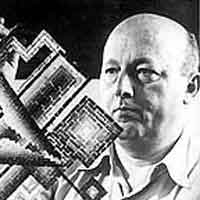
In spite of what you might believe, eccentricity wasn’t exclusive to the aristocracy. Long haired people existed during this aristocrat's youth; in order to demonstrate this exceptional and hard to believe truth, this German Count watched in his private cinema a film collection of the most reputable and avant-garde German film makers of the early 20’s because besides “Kammerspiele” there was room too for risky film innovations during the silent German days.

Oeuvres from Herr Hans Richter ( “Rhythmus 21”, “Vormittagsspuk” & “Fimstudie”), Herr Walter Ruttmann ( “Opus 1” ) and Herr Oskar Fischinger ( “Seelische Konstruktionen”, “Studie Nr. 7” & “Komposition In Blau” ) confirm with their film boldness this aristocrat assertion: during the Weimar Republic there were German long haired avant-garde film makers!!.
Those films were very experimental and used many innovative techniques, ( slow and stop motion, silhouettes, paintings, negative film exposures…) not forgetting the astonishing use of geometrical figures, colour and music ( the performance of those squares, triangles or even rectangular are superb and even superior to many flesh and blood silent actors ), to achieve an incredible, original and abstract animation symphony that fascinated even a conservative German count, opened his mind and scarce imagination and actually made him think of subjects other than German fat heiresses .....at least for a few minutes.

Imaginative and abstract these avant-garde German silent films demonstrate great dynamism and versatility and display some of the most important cinematography of the world during the silent era.
And now, if you'll allow me, I must temporarily take my leave because this
German Count must investigate the quadrature of a circle.
Herr Graf Ferdinand Von Galitzien
-/-
A pesar de lo que ustedes puedan creer, la excentricidad no es exclusiva de la aristocracia pues los melenudos han existido incluso durante los años mozos de éste aristócrata; para demostrar esta excepcional, dura e increíble verdad, este Conde germánico ha visto en su cine privado una colección de filmes de los más reconocidos y vanguardistas directores germánicos de principios de los años 20 y es que además del “Kammerspiele”, también había espacio para arriesgadas innovaciones fílmicas durante los años silentes teutones…
Obras de Herr Hans Richter ( “Rhythmus 21”, “Vormittagsspuk” & “Filmstudie” ), Herr Walter Ruttmann ( “Opus 1” ) y Herr Oskar Fischinger ( “Seelische Konstruktionen”, “Studie Nr. 7” & “Komposition In Blau” ) nos confirman con su atrevimiento, la aseveración de éste aristócrata: ¡durante la República de Weimar había realizadores alemanes melenudos!!.
Esos filmes eran muy experimentales y usaban variadas e innovadoras técnicas ( cámara lenta, “stop motion”, siluetas, pintura, exposición de negativos… ) sin olvidar el sorprendente uso de figuras geométricas, color y música ( la actuación de esos cuadrados, triángulos o incluso rectángulos, es realmente soberbia e incluso superior a la de bastantes actores silentes de carne y hueso ), para conseguir una increíble, original y abstracta sinfonía animada que fascina incluso a un conservador conde germánico, consiguiendo que abra su mente y escasa imaginación a algo más que pensar en grosas herederas teutonas aunque sea por lo menos durante unos minutos.
Estos imaginativos y abstractos filmes silentes vanguardistas germanos, nos vienen a demostrar y mostrar el gran dinamismo y versatilidad de una de las más importantes cinematografías del mundo durante la época silente.
Y ahora si me lo permiten les tengo que dejar momentáneamente, pues este Conde germánico tiene que investigar acerca de la cuadratura del círculo.
Herr Graf Ferdinand Von Galitzien

2 Kommentare:
Dear Count - I was wondering if you'd had a chance to peruse some of Lotte Reiniger's work (she of The Adventures of Prince Achmed). There's some of the same use of geometric images à la Opus 1 in Prince Achmed (around the beginning). Apparently Ruttmann, Bertolt Bartosch, and Alex Kardan aided on the production, so there was definitely cross-pollination. I haven't seen any of her other work to tell if she often did this, or this was a one-off influenced by her co-artists.
- Lady Wakasa
(still ungraciously jealous of your film access)
Mein liebe Damen Lady Wakasa:
I'm afraid that you are right, Damen Wakasa ( a terrible fact... to know that even the middle classes have right in some subjects... ) because, as you said, Lotte Reiniger's "Die Abentuer Des Prinzen Ahmed" were highly influenced by the work of those German artists although that geometrical influences are not very evident in other Reiniger films.
On the contrary, this German Count has perceived some Reiniger influence in Herr Fischinger work, specially in "Seelische Konstruktionen" (Spiritual Constructions), in the use, movements and imaginery about those two silhouetted male figures that can be seen in that Fischinger animated film.
By the way, this German Count raise his eyebrows for your recommendation about this modern silent diary on your webpage... if this German aristocrat were human, he would be very touched about that... and don't worry about your jelousy about the aristocrat access to rare silent films, you only have to write to the "Schlöss" ( FerdinandVonGalitzien@gmail.com ) in order to get any silent film from this German Count archives.
Herr Graf Ferdinand Von Galitzien
Kommentar veröffentlichen